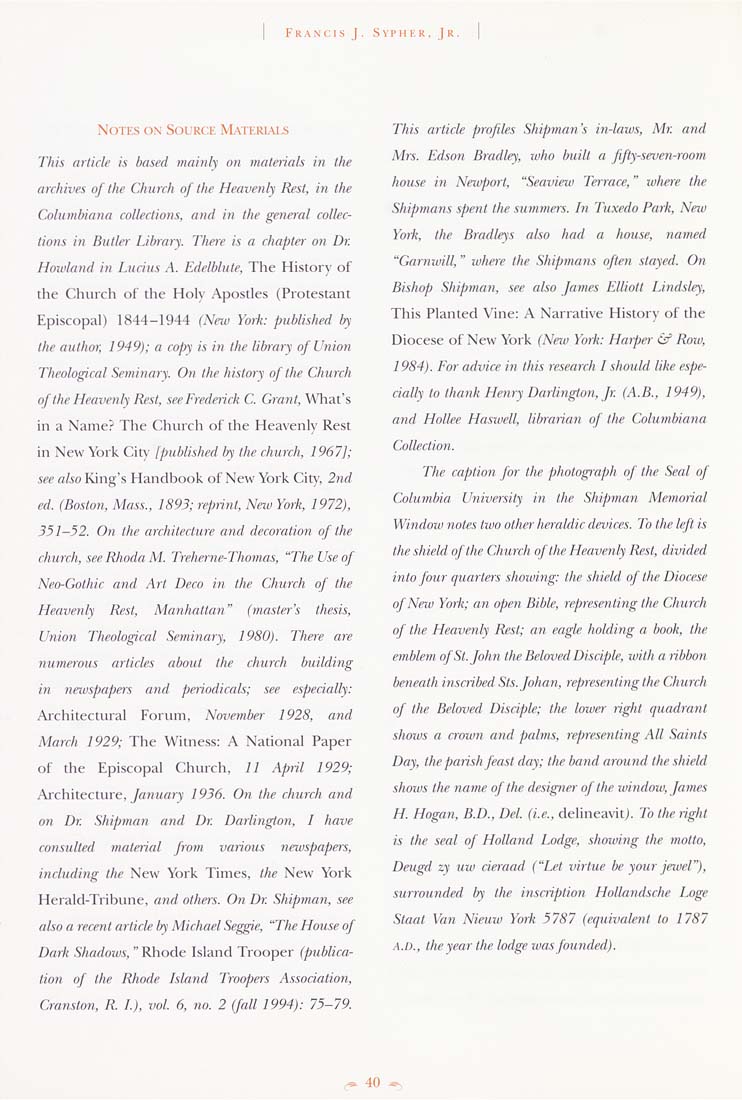Columbia Library columns (v.45(1996))
(New York : Friends of the Columbia Libraries. )
|
||
|
|
|
|
| v.45,no.2(1996:Autumn): Page 40 |

Francis J. Sypher, Jr.
Notes on Source Materials
'fhis article is based mainly on materials in the
archives of the Church of the Heavenly Rest, in the
Columbiana collections, and in the general collec¬
tions in Butler Library. There is a chapter on Dr.
Howland in Lucius A. Edelblute, The History of
the Chinch of the Holy Apostles (Protestant
Episcopal) 1844-1944 (New York: published by
the author, 1949); a copy is in the library of Union
Theological Seminary. On the history of the Church
of the Heavenly Rest, see Frederick C. Grant, Wliat's
in a Name? The Church of the Heavenly Rest
in New York City [published Iry the church, 1967];
see also King's Handbook of New York Cit)', 2nd
ed. (Boston, Mass., 1893; reprint. New York, 1972),
351-52. On the architecture and decoration of the
chiiirh, sec Rlioda M. Trebcnie-Thomas, "The Use of
Neo-Gothic and. Art Deco in the Church of the
Heaxjenly Rest, Manhattan" (master's thesis.
Union Theolo^cal Seminary, 1980). There are
numerous articles about the church building
in newspapers and periodicals; see especially:
Architectural Forum, November 1928, and
March 1929; The Witness: A National Paper
of the Episcopal Church, 11 April 1929;
Architecture, Jantiary 1936. On the church and
on Dr. Shipman and Dr. Darlington, I have
consulted material from various newspapers,
including the New York Times, the New York
Herald-Tribune, and others. On Dr Shipman, see
also a recent article by Michael Seggie, "The House of
Dark Shadows, " Rhode Island Trooper (publica¬
tion of the Rhode Island Troopers Association,
Cranston, R. L), vol. 6, no. 2 (fcdl 1994): 75-79.
This article profiles Skipman's in-laws, Mr. and
Mrs. Edson Bradley, who built a fifty-seven-room
house in Newport, "Seaview Terrace," where the
Shipmans spent the summers. In Tuxedo Park, New
York, the Bradleys also had a house, named
"Garnwill," where the Shipmans often stayed. On
Bishop Shipman, see also James Elliott Lindsley,
This Planted Vine: A Narrative History of the
Diocese of New York (Neio York: Harper & Row,
1984). For advice in this research I should like espe¬
cially lo thank Henry Darlington, Jr. (A.B., 1949),
and Holke Haswell, librarian of the Columbiana
Collection.
The caption for the photograph of the Seal of
Columbia University in the Shipm/in Memmial
Window notes two otbcr bcnildic devices. To the left is
the shield of the Church of the Heavenly Rest, divided
into four quarters showing: the shield of the Diocese
of New York; an open Bible, representing tbe Church
of the Heavenly Rest; an eagle holding a book, the
emblem of St. John the Beloved Disciple, with a ribbon
beneath inscribed Sts.Johan, representing the Church
of the Beloved Disciple; the lower right quadrant
shows a crown and palms, representing All Saints
Day, the parish feast day; the band around the shield
shows the name of the designer of the xuindow, James
H. Hogan, B.D., Del (i.e., delineavit). To the right
is the seal of Holland Lodge, showing the motto,
Deugd zy uw cieraad ("Let virtue be your jeivel"),
surrounded by the inscription Hollandsche I^oge
Staat Van Nieuw York 5787 (equivalent to 1787
A.D., the year the lodge was founded).
|
| v.45,no.2(1996:Autumn): Page 40 |







